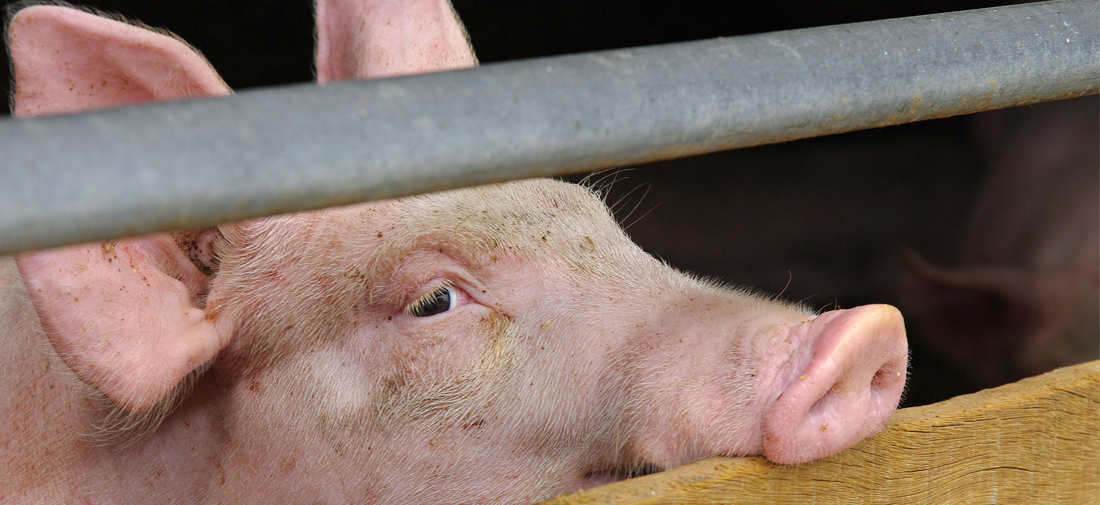Toxin binders as a solution to tail biting?
Despite constant monitoring of influencing factors such as climate, feed and animal health, pigs continue to bite their tails time and time again.
This occurs entirely independently of whether the pig has previously had its tail docked. Even if there was nothing visible on the previous day, farmers find themselves observing one or more animals in a cove with reddened tails, and sometimes even a bloody patch, the next morning.
The affected animals suffer significant pain, caused in particular by large and inflamed bite wounds. In the absence of a swift response, this is often followed by progressive infections of the spinal cord. These can lead to spread of pathogens and formation of abscesses throughout the animal’s body.
Tail biting is a behavioural disorder caused by a multitude of factors, which is generally the result of the animal becoming overwhelmed by various stress factors. These stress factors can be highly diverse and mutually aggravate one another. An important stress factor is poor regulation of the sty climate, resulting in drafts, excessive harmful gases or insufficient fresh air. Severe heat stress and the associated poor air quality in particular give rise to an increased concentration of harmful gases. This results in an increase in the concentration of endotoxins, toxic substances from gram-negative bacteria, in the sty air. Heat stress as well as poor feed quality (increased mycotoxin contamination) can thus inflame the intestinal mucosa, cause dysbiosis and thereby increase the concentration of endotoxins in the intestine. The endotoxins then proceed via the lungs and the intestine to reach the bloodstream. Once there, they are normally first bound to blood proteins and neutralised. The central organ for eliminating them, in addition to the lungs and kidneys, is the liver, where the endotoxins are metabolised, transferred to hepatocytes and eliminated via the bile and intestine. Should the neutralisation capacity become exhausted, however, this will trigger an inflammatory cascade. The inflammation mediators result in fever, pain, an increased heart rate, blood clots in the capillaries and a weakening of the immune system.
In practice, the appearance of laminitis is observed in pigs as early as when they are piglets, which manifests as bleeding of the trotters and inflammation in the sole area. This can be observed as early as the first day of life. It is followed by necrosis on the tail and ears. The elimination and breakdown of endotoxins takes several weeks and is extremely burdensome. During this period, the animal is not able to grow at the optimal rate. Sub-clinical stresses arise on a daily basis and often without symptoms. The animals channel nutrients in different ways in order to, for example, activate their immune systems, whereas these would otherwise be used for growth and productivity. It is estimated that 10 to 20% of the resorbed nutrients are lost. There is no doubt that intact intestinal flora constitutes a requirement for health. In order to reduce the use of medication over the long term, a holistic view of the gastrointestinal tract and its associated immune system should thus be taken at all ages of the animal, with these also being supported in a preventative manner through various methods.
Especially in young, growing animals whose immune system has not yet developed, as well as in animals used in reproduction, it is recommended that an EU-approved mycotoxin deactivation product, such as MiaBond 360, be used as standard for preventative and precautionary purposes. This allows sub-clinical stresses to be prevented and supports full nutrient uptake. An additional benefit of this product is the effective binding of the endotoxins in the intestinal lumen as well as the fact that it contains protective polyphenols. This provides the animals with protection not just from toxins, but also from oxidative stress, which can be triggered by numerous factors and have far-reaching consequences for the animal’s health and performance. The natural polyphenols in MiaBond 360 were selected due to their high anti-oxidative capacity.
Dr. Marlene Luttmann (Head of PLM Toxin Binder, MIAVIT GmbH)
